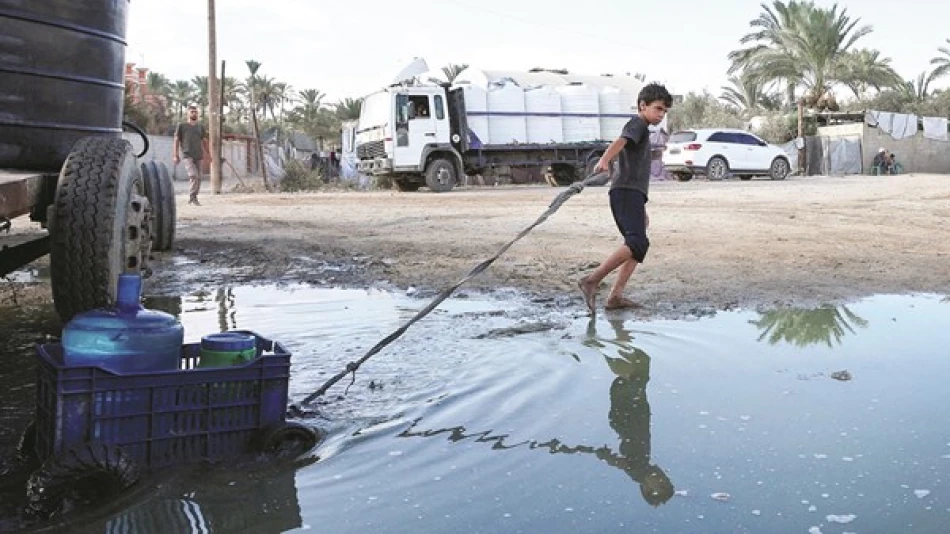
Gaza Braces for Outbreak of 'Ghailan Bariah' Virus Amid Lack of Treatment Options
Gaza Faces Guillain-Barré Syndrome Outbreak as Health Crisis Deepens Under Siege Conditions
Palestinian health authorities have reported a dangerous outbreak of Guillain-Barré syndrome in Gaza, with 95 confirmed cases including 45 children and three deaths, highlighting how the ongoing conflict has created conditions ripe for neurological diseases typically seen in areas with collapsed infrastructure. The outbreak, linked to contaminated water and severe malnutrition, underscores the cascading health consequences of prolonged siege warfare in one of the world's most densely populated areas.
A Rare Neurological Disease Takes Hold
Guillain-Barré syndrome, a condition where the immune system attacks the peripheral nervous system, has emerged as Gaza's latest health emergency. Dr. Munir al-Barsh, Director General of Gaza's Health Ministry, confirmed that contaminated water supplies and widespread malnutrition have created ideal conditions for the disease's spread.
The syndrome typically begins with sudden muscle weakness in the lower extremities before progressing upward, potentially causing respiratory failure and death. What makes this outbreak particularly concerning is the complete absence of treatment options – the immunoglobulin therapy and plasma exchange procedures typically used to treat Guillain-Barré are unavailable in Gaza's decimated healthcare system.
Infrastructure Collapse Fuels Disease Transmission
The outbreak reflects a broader pattern of disease emergence in conflict zones where basic infrastructure fails. Gaza's population is now compressed into just 18% of the territory's original area, creating a population density of 40,000 people per square kilometer – conditions that accelerate disease transmission exponentially.
Beyond Guillain-Barré, health authorities have recorded 1,116 cases of meningitis this year and a rapid spread of respiratory diseases. This disease profile mirrors historical patterns seen in besieged cities, where contaminated water and overcrowding typically produce neurological and infectious disease outbreaks within months of infrastructure collapse.
The Water-Disease Connection
Guillain-Barré syndrome often follows bacterial infections, particularly Campylobacter jejuni, commonly transmitted through contaminated water. Gaza's water treatment facilities have been severely damaged, forcing residents to rely on questionable water sources. This creates a direct pathway for the bacterial infections that can trigger the autoimmune response characteristic of Guillain-Barré.
International Health Response Remains Limited
Despite notifying the World Health Organization when cases first appeared, Palestinian health authorities report no meaningful international intervention. This response gap reflects the complex logistics of medical aid delivery in active conflict zones, but also highlights how political considerations can impede public health responses.
The lack of treatment availability represents a particularly stark challenge – Guillain-Barré syndrome requires intensive care facilities and specialized medications that are standard in developed healthcare systems but impossible to maintain under siege conditions.
Broader Humanitarian Crisis Accelerates
The neurological outbreak occurs against a backdrop of escalating casualties and systematic hunger. Palestinian authorities reported 87 deaths and 644 injuries in the latest 24-hour period, while hospitals recorded eight additional deaths from starvation – bringing the total death toll since October 7, 2023, to 61,020 killed and 150,671 wounded.
Particularly telling are the casualties among those seeking humanitarian aid: 52 Palestinians were killed and 352 wounded while attempting to reach relief supplies, bringing the total number of aid-seekers killed to 1,568, with over 11,230 wounded, mostly by gunfire.
Medical System at Breaking Point
Gaza's hospitals face acute shortages of medications and supplies, with diagnostic and treatment capabilities near total collapse. This creates a cascading effect where treatable conditions become fatal, and preventable diseases spread unchecked through the population.
The Guillain-Barré outbreak may represent an early indicator of more severe public health crises to come, as the combination of malnutrition, contaminated water, and healthcare system collapse creates conditions historically associated with major disease emergencies. Without immediate intervention to restore basic infrastructure and medical supplies, Gaza faces the prospect of preventable diseases claiming lives on a scale that could eventually rival direct conflict casualties.
Most Viewed News

 Layla Al Mansoori
Layla Al Mansoori






